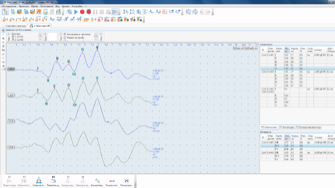Catalog

NPF "META-KHROM"
73 products
View:
Telephone number:
E-mail:
m_chrom@mari-el.ru
Website: https://www.meta-chrom.ru/
Address:
Russia, Yoshkar-Ola, null, 100null
Адрес:
Russia, Yoshkar-Ola, null, 100null
- Selected: 0Applying
- Selected: 0Names
- Selected: 0Manufacturer
- Selected: 0Made in
- Selected: 0Additional
View:
71 products
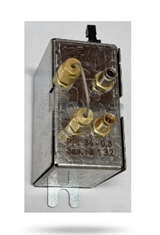
GAS FLOW REGULATOR
The flow regulator consists of the following parts:
Body. It includes a connector for connection to the control controller and fittings for connecting the input and output gas lines.
Calorimetric converter. Due to the heating of the gas along the flow section, the temperature difference is determined.
The actuator (solenoid valve).
The control board. A system of elements responsible for converting the signals that the user submits.
TECHNICAL CHARACTERISTICS OF RD
The gas pressure at the inlet is (0.4 + 0.04) MPa.
Ranges of working gas flow rates — from 5 to 800 ml/min. The ability to specify the type of gas (nitrogen, helium, hydrogen, argon, air).
Pressure ranges — from 0.001 to 0.40 MPa with a discreteness of 0.0001 MPa.
The deviation of the carrier gas flow rate from the average value is + 1.5% in the flow range from 50 to 100 ml/min and + 0.5 ml/min in the flow range from 3 to 50 ml/min.
Relative deviation of the average steady-state gas flow rate from the set value in the range
from 3 to 100 ml/min: + 2.5%, but not less than 0.5 ml/min;
from 100 to 200 ml/min.: + 5%;
from 200 to 800 ml/min.: + 10%.
The gas pressure at the inlet is (0.4 + 0.04) MPa.
The deviation of the regulated output pressure of the regulator from the set value is not more than 1%.
NPF "META-KHROM"
Yoshkar-Ola
Produced in: Yoshkar-Ola, Mari El
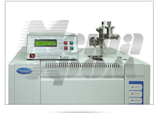
PYROLYZER
The pyrolytic gas chromatography method is widely used in the study of polymer materials, plastics, rubbers, rubbers, paints and other high-molecular compounds of natural and artificial origin. The method is based on thermal decomposition of sample samples in an inert medium (without oxygen access), followed by chromatographic separation and analysis of the formed volatile compounds. Thus, the resulting pyrogram allows us to judge the composition of the original sample. Pyrolysis is also used in geochemical studies.
Technical specifications
The volume of the capsule is 56 ml.
Pyrolysis temperature — from 200 to 1000 °C.
The error of maintaining the temperature is not more than 1.0 ° C.
The heating time of the sample to the pyrolysis temperature is no more than 2 seconds.
The cooling time of the capsule when moving from the hot zone to the cold zone after pyrolysis is no more than 10 seconds.
The time of continuous operation in the pyrolysis mode is no more than 60 seconds.
Electric power supply from the AC network with voltage (220index) V, frequency (50 ± 1) Hz.
Power consumption — no more than 100 VA.
Overall dimensions of the control unit (width ×depth×height) — 210×190×100 mm.
Overall dimensions of the input node (width× depth×height) — 90×135×160 mm.
The weight of the control unit is not more than 2.5 kg.
The weight of the input node is not more than 0.9 kg.
NPF "META-KHROM"
Yoshkar-Ola
Produced in: Yoshkar-Ola, Mari El
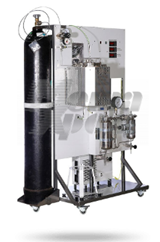
PILOT COKING PLANT. ISM CODE.413224.018
The unit is designed to simulate and study the processes of delayed coking occurring at elevated temperature and pressure in a stainless steel reactor made in the form of a flask with a spherical bottom and a removable lid. The installation allows you to obtain experimental data, select and optimize the parameters of the technological process, test various variants of raw mixtures, determine the material balance of the process, the characteristics of the process products.
Ambient temperature from +10 to +35C;
The relative humidity of the air is not more than 80% at a temperature of 25C;.
The power supply is a single-phase AC network with a voltage of 230-240V 50-60 Hz.
The average service life of the autoclave is 6 years.
TECHNICAL CHARACTERISTICS
Operating pressure range, MPa 0÷0.6
Reactor operating temperature range, 0C 50÷550
The discreteness of the temperature setting is 0C 1
Relative error of temperature maintenance, 0C ± 0.2
Reactor material steel 12x18N10T
Power consumption, kW not more than 3
Overall dimensions (HxWxD) 1600x1100x495
Weight, kg 240
Continuous operation mode
NPF "META-KHROM"
Yoshkar-Ola
Produced in: Yoshkar-Ola, Mari El
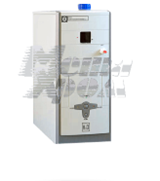
WATER PURIFICATION DEVICES: AQUARIUS DEVICE
Water purification in the device is carried out by passing it through a composition of deionization resins and sorbents. Resins and sorbents are located in filter elements placed in a replaceable cassette. The distilled water to be cleaned is poured into the feed tank, the filler neck of which is placed on the upper plane of the device and hermetically sealed with a screw cap.
Technical specifications:
The specific conductivity of the resulting water, not more than, mkSxcm 0.20
Capacity, at least, l/h 6
Operating time of the replaceable cassette (total volume of purified water), not less than 700 liters
Volume of refilled distilled water, l. 1
Power consumption, not more than, VA 20
Overall dimensions (width×depth×height), mm 180×450×380
NPF "META-KHROM"
Yoshkar-Ola
Produced in: Yoshkar-Ola, Mari El
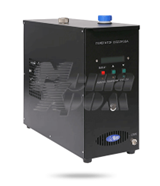
HYDROGEN GENERATOR (HW) 7, 12, 16, 25 LITERS
The hydrogen generator is equipped with its own microprocessor, with which you can control the operating modes of the device. It is microprocessor control that determines the autonomy of the device. Moreover, this allows you to control the basic and technical parameters of the device (pressure, flow rate, level of water poured into the tank, tightness of gas lines, electrolyzer current). For the manufacture of gas lines, exclusively inert materials are used.
Technical specifications:
The device is equipped with a four-button keyboard, which is used to set parameters and control. The generator can operate in continuous mode for a long time. For refueling, especially pure or double-distilled water is used, and refueling can be done without turning off the device, on the go. Their advantage is that they significantly reduce, or even completely eliminate, the use of bottled gases to power chromatographs and gas analyzers. For nutrition, mainly double-distilled water is used, the quality of which must be no lower than grade B water according to OST 11.029.003–80, and the electrical resistivity must be no less than 1 Mohm x cm.
The devices operate from a single-phase AC electrical network with voltage from 187 to 242 W, frequency (50±1) Hz. Maximum safety of devices is achieved due to the absence of such a supply of substance in them, which could fill a chromatograph or laboratory in a short period of time. The performance of the device eliminates the occurrence of explosive situations, so the generator is considered safe to use.
The device is equipped with a four-button keyboard, which is used to set parameters and control. The generator can operate in continuous mode for a long time. For refueling, especially pure or double-distilled water is used, and refueling can be done without turning off the device, on the go. Their advantage is that they significantly reduce, or even completely eliminate, the use of bottled gases to power chromatographs and gas analyzers. For nutrition, mainly double-distilled water is used, the quality of which must be no lower than grade B water according to OST 11.029.003–80, and the electrical resistivity must be no less than 1 Mohm x cm.
The devices operate from a single-phase AC electrical network with voltage from 187 to 242 W, frequency (50±1) Hz. Maximum safety of devices is achieved due to the absence of such a supply of substance in them, which could fill a chromatograph or laboratory in a short period of time. The performance of the device eliminates the occurrence of explosive situations, so the generator is considered safe to use.
NPF "META-KHROM"
Yoshkar-Ola
Produced in: Yoshkar-Ola, Mari El
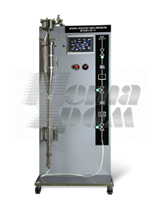
AUTOMATED INSTALLATION FOR DETERMINING THE WEAR OF THE CATALYST
An automated installation for determining the wear of various catalysts, including KPS (FCC) for cracking with a fluidized bed by an air jet and is designed to determine the comparative wear characteristics of the KPS (FCC) of the catalyst by friction of an air jet according to ASTM D5757-11.
It is used for testing with irregularly shaped spherical sludge particles (size from 10 to 180 microns).
Abrasion is achieved by fluidization of the sample under the influence of jets of moist air. The percentage of fine particles (less than 20 microns in size) after a 5-hour test is an air jet abrasion index (AJI).
technical specifications
The range of operating air pressures for the power supply of the installation is 0.8±0.1 MPa
The range of air flow rates for the power supply of the installation is not less than (l/min) 20
Absolute error of the air flow rate maintained automatically at a flow rate of 10 l/min. no more, l/min. ± 0.05
Power consumption not more than 0.2 kW
Overall dimensions, mm and weight kg. 560x760x1700, 30
Abrasion pipe made of steel 12x18 n10t with dimensions, mm 710±10, 35 ± 0.5
Three sapphire nozzles with a diameter and length, mm 0.381±0.005, 2±1.0
Continuous operation mode
Control: microprocessor with tactile control for setting the display and automatic maintenance of installation parameters and mathematical processing of analysis results 60
The convergence of the results when testing the same catalyst is not more than 0.1%
NPF "META-KHROM"
Yoshkar-Ola
Produced in: Yoshkar-Ola, Mari El
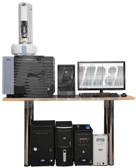
Gas chromatograph Crystallux-4000m
The gas chromatograph "Kristallux-4000M" is fully automated, starting from sample input and ending with chromatographic information processing, including the functions of automatic temperature control of thermostats, flow rates and pressure of the carrier gas (EUPG system), auxiliary gases, automatic ignition of detectors, flame burning control during operation, measurement of detector signals using Gorenje 24-bit ADC.
Technical specifications:
The detection limit of PID is 1,1x10-12 gS/s for h-hydrocarbons 1,1x10-12 gS/s for propane.
The detection limit of DTP1.7x10-14 g/s for lindane
3.9x10`15 g/s for lindane (micro-ED)
The detection limit of EZD1x10`13 grus for phosphorus in metaphos
8x10`13 g5/s for sulfur in metaphos or hydrogen sulfide
PFD detection limit
1.5x10`14 g/s for phosphorus in metaphos
3x10`13 GM/s for nitrogen in azobenzene
Detection limit of TID2x10`10 g/ml by hydrogen
The detection limit of TcD is 5x10`13 g/s for benzene
The detection limit of the FEED is 3x10`13 g/s for carbon in methane 3x10`13 g/s for carbon in methane
Detection limit GID500:1 (M7-801) with the introduction of 1x10`12 g / ml of octafluoroaphthalene
The signal-to-noise ratio of MSD 1500:1 (Maestro-oMS) when entering 1x10`12 g / ml of octafluoroaphthalene
Linear dynamic range of PID x1*107
Linear dynamic range DTP1*108
The volume of the column thermostat is 14 (19)l
The temperature of the column Current.Wednesday
+3 °C to +400 °C
(by special order up to 450 °C)
(by special order from -10°C
with use. cold. ust-ki)(by special order from -100 °C.
with use. liquid, no.)
The discreteness of the temperature setting is 0, ° C
Temperature stability 0.01 °C
Temperature programming speed 0t 0.1 to 125 °C/min (by special order up to 150 °C/min)
The number of isotherms is not less than 30
The cooling rate of the column thermostat is from 400 to 50 °C3.3 min.
The maximum temperature of the detector and evaporator is 450 °C
Carrier gas consumption from 0 to 100 ml/min.(by special order up to 500 ml/min.)
Carrier gas pressure (for capillary column) from 0 to 0.40 Mpa
(by special order up to 1 MPa)
The maximum inlet gas pressure on a special order is 0.5 MPA
1.25 MPA
Hydrogen consumption 0-500
Air consumption 0-1000
Overall dimensions (width x depth x height) 550%500*500 mm
Weight 39 kg
Electric power supply from AC mains voltage (220.2) V, frequency (50 +1) Hz
The maximum power consumption (in steady-state mode) is 900 VA.
NPF "META-KHROM"
Yoshkar-Ola
Produced in: Yoshkar-Ola, Mari El
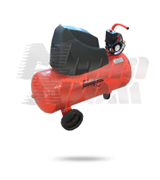
FUBAG TYPE AIR COMPRESSOR
Household oil—free piston compressor - designed specifically for non-professional users.
Technical specifications:
Capacity, l/min 230
Pressure, atm 8
Engine power, kW 1,1
Receiver volume, l 50
Noise level, 80 dB
Weight, kg 35
Overall dimensions (length×depth×height), mm 750×320×700
Single-phase mains voltage 220 V, 50 Hz
NPF "META-KHROM"
Yoshkar-Ola
Produced in: Yoshkar-Ola, Mari El
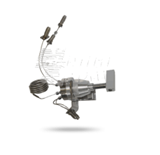
METERING VALVE FOR GAS SAMPLES
The metering valve for the introduction of gas samples is designed for the introduction of gas under excessive pressure into the chromatograph. Cranes differ in the number of moves (4, 6, 8, 10, 12) and have two provisions "Selection" — "Analysis". In addition to dosing, cranes can be used to switch chromatographic columns, elements of gas circuits, etc. The tap can be installed either on the side panel of the chromatograph, or directly into the analytical module instead of, or together with the evaporator of the chromatograph, while it is used as a back-purge tap or for hot sample entry. Additionally, the tap for hot entry can be equipped with heated pipelines.
technical specifications
The dose volume is from 0.25 to 5.0 ml (at the request of the consumer, the dose volume can be increased to 10 ml and reduced to 0.1 ml).
The maximum temperature of the tap is no more than 160 °C.
The pressure in the crane line is not more than 0.48 MPa.
The angle of rotation of the crane handle — depending on the number of strokes.
NPF "META-KHROM"
Yoshkar-Ola
Produced in: Yoshkar-Ola, Mari El

Thermal Conductivity Detector(accident)
It is used to determine hydrogen, oxygen, CO and combustible hydrocarbon gases, and its sensitivity to these compounds is higher than the sensitivity of an accident. The most widespread TCD was obtained for the analysis of hydrogen and oxygen, tk. its sensitivity to them is almost an order of magnitude higher than that of an accident. The principle of operation is based on fixing the thermal effect of catalytic combustion of the sample on the surface of the platinum filament.
Technical characteristic:
1.8*10`10 g/ml of hydrogen
NPF "META-KHROM"
Yoshkar-Ola
Produced in: Yoshkar-Ola, Mari El
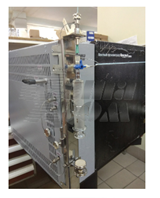
SYRINGE FILLING DEVICE
When analyzing gases dissolved in transformer oil using the ARP method (equilibrium vapor analysis), it is necessary to first fill a syringe with transformer oil with a carrier gas, and then, after achieving an equilibrium distribution of gases dissolved in oil between the liquid and gas phases, introduce the gas phase into the chromatograph (blow out the doses of the chromatograph dispenser tap). Moreover, the operations of filling the syringe and entering the sample are performed without air access. When filling the syringe, it is possible to fix the syringe stem at a certain volume.
technical specifications
The volume of syringes is 20 or 50 ml.
The pressure at the outlet of the syringe filling line with argon is 0.5 atm.
The range of ratios of volumes of the gas phase and oil (Vg/Vm) is from 0 to 1.5.
NPF "META-KHROM"
Yoshkar-Ola
Produced in: Yoshkar-Ola, Mari El
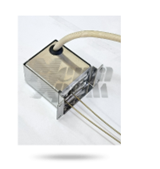
METANATOR
To analyze small concentrations of carbon monoxide (CO) and carbon dioxide (CO2), instead of the usual catarometer for these gases, a more sensitive PID is used, while carbon oxides are converted into methane (CH4) using reaction chromatography. The device implementing the conversion reaction is called a methanator, i.e. a device with a special catalyst that converts CO, CO2 into methane in a hydrogen current, while the latter is either a carrier gas itself, or is blown together with the carrier gas into the methanator through a tee. The methanator provides a highly efficient conversion reaction, while the detection limit of carbon oxides reaches 0.1 ppm.
technical specifications
Metanation temperature — 330 °C
The coefficient of metanation is not less than 95 %
The effective volume of the methanator is 1 ml.
NPF "META-KHROM"
Yoshkar-Ola
Produced in: Yoshkar-Ola, Mari El
